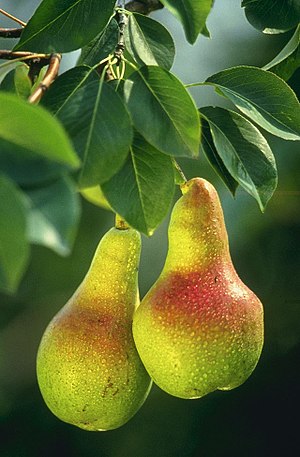Pyrus
| Pears | |
|---|---|
 | |
| Genus: | Pyrus |
| Family: | Rosaceae |
| Type: | Trees and shrubs |
| Pollination: | Insects |
| Toxicity and edibility: | Fruit of some species are edible (pears) |
A pear is a tree of the genus Pyrus and the juicy fruit of that tree, edible in some species. The English word pear is probably from Common West Germanic *pera, probably a loanword of Vulgar Latin pira, the plural of pirum, which is itself of unknown origin. See also Peorð. The place name Perry can indicate the historical presence of pear trees.
Description
editPears are native to temperate regions of the Old World, from western Europe and north Africa east right across Asia. They are medium sized trees, reaching 10-17 m tall, often with a tall, narrow crown; a few species are shrubby. The leaves are alternately arranged, simple, 2-12 cm long, glossy green on some species, densely silvery-hairy in some others; leaf shape varies from broad oval to narrow lanceolate. Most pears are deciduous, but one or two species in southeast Asia are evergreen. Most are cold-hardy, withstanding temperatures between −25 °C and −40 °C in winter, except for the evergreen species, which only tolerate temperatures down to about −15 °C.
The flowers are white, rarely tinted yellow or pink, 2-4 cm diameter, and have five petals. Like that of the related apple, the pear fruit is a pome, in most wild species 1-4 cm diameter, but in some cultivated forms up to 18 cm long and 8 cm broad; the shape varies from globose in most species, to the classic 'pear-shape' of the European Pear with an elongated basal portion and a bulbous end.
Growing conditions
editSpecies
edit- Pyrus amygdaliformis – Almond-leafed Pear
- Pyrus betulifolia
- Pyrus xbretschneideri - Chinese White Pear
- Pyrus calleryana – Callery Pear
- Pyrus caucasica – Caucasian Pear
- Pyrus communis – European Pear
- Pyrus cordata – Plymouth Pear
- Pyrus cossonii – Algerian Pear
- Pyrus elaeagrifolia – Oleaster-leafed Pear
- Pyrus fauriei
- Pyrus kawakamii
- Pyrus korshinskyi
- Pyrus lindleyi
- Pyrus nivalis – Snow Pear
- Pyrus pashia – Afghan Pear
- Pyrus phaeocarpa
- Pyrus pyraster – Wild Pear
- Pyrus pyrifolia – Nashi Pear
- Pyrus regelii
- Pyrus salicifolia – Willow-leafed Pear
- Pyrus salvifolia – Sage-leafed Pear
- Pyrus ×serrulata
- Pyrus syriaca
- Pyrus ussuriensis – Siberian Pear
Uses
editPear trees are used as food plants by the larvae of a number of Lepidoptera species - see w:List of Lepidoptera which feed on Pear trees.
Only three species are important for edible fruit production, the European Pear Pyrus communis cultivated mainly in Europe and North America, the Chinese white pear (bai li) Pyrus xbretschneideri, and the Nashi Pear Pyrus pyrifolia (also known as Asian Pear or Apple Pear), both grown mainly in eastern Asia. There are thousands of cultivars of these three species.
Other species are used as rootstocks for European and Asian pears and as ornamental trees. The Siberian Pear, Pyrus ussuriensis (which produces unpalatable fruit) has been crossed with Pyrus communis to breed hardier pear cultivars. The Bradford Pear (Pyrus calleryana 'Bradford') in particular has become widespread in North America and is used only for decoration. The Willow-leafed Pear (Pyrus salicifolia) is grown for its attractive slender, densely silvery-hairy leaves.
Pears are consumed fresh, canned, as juice, and occasionally dried. The juice can also be used in jellies and jams, usually in combination with other fruits or berries. Fermented pear juice is called perry.
Pears are the least allergenic of all fruits. Along with lamb and soya formula, pears form part of the strictest exclusion diet for allergy sufferers.
Pear wood is one of the preferred materials in the manufacture of high-quality woodwind instruments and furniture. It is also used for wood carving, and as a firewood to produce aromatic smoke for smoking meat or tobacco.
Maintenance
editPropagation
editThe pear is very similar to the apple in cultivation, propagation and pollination.